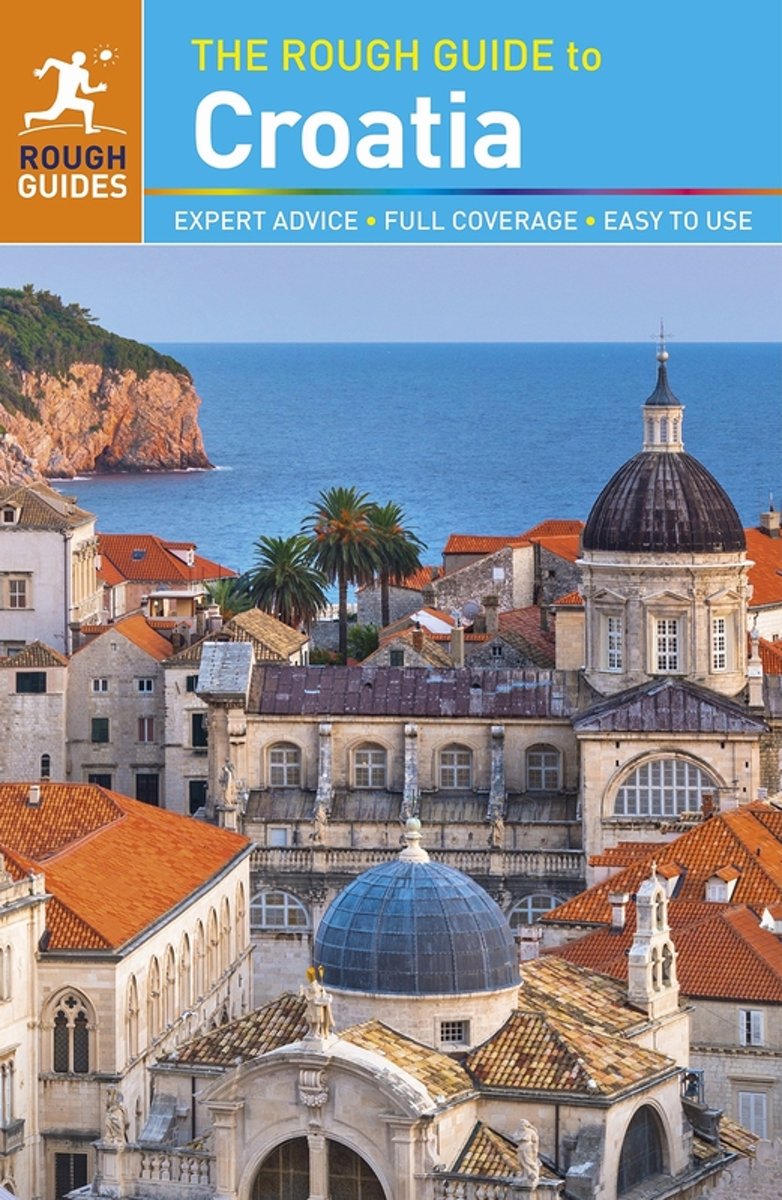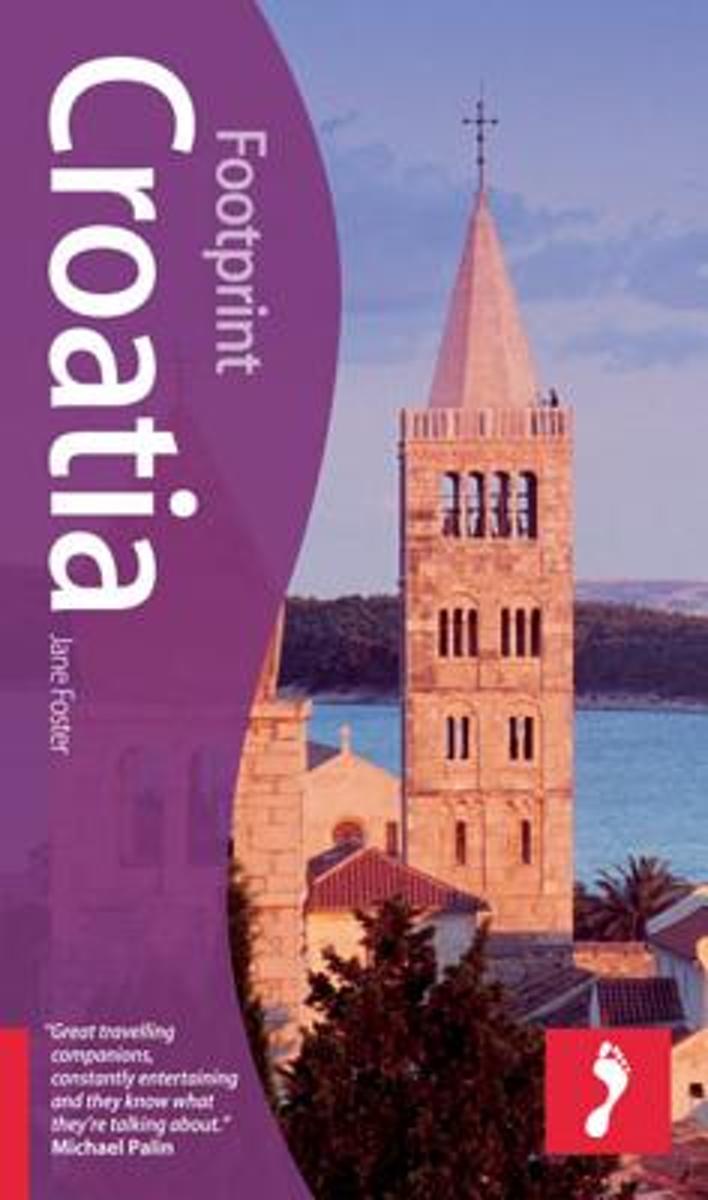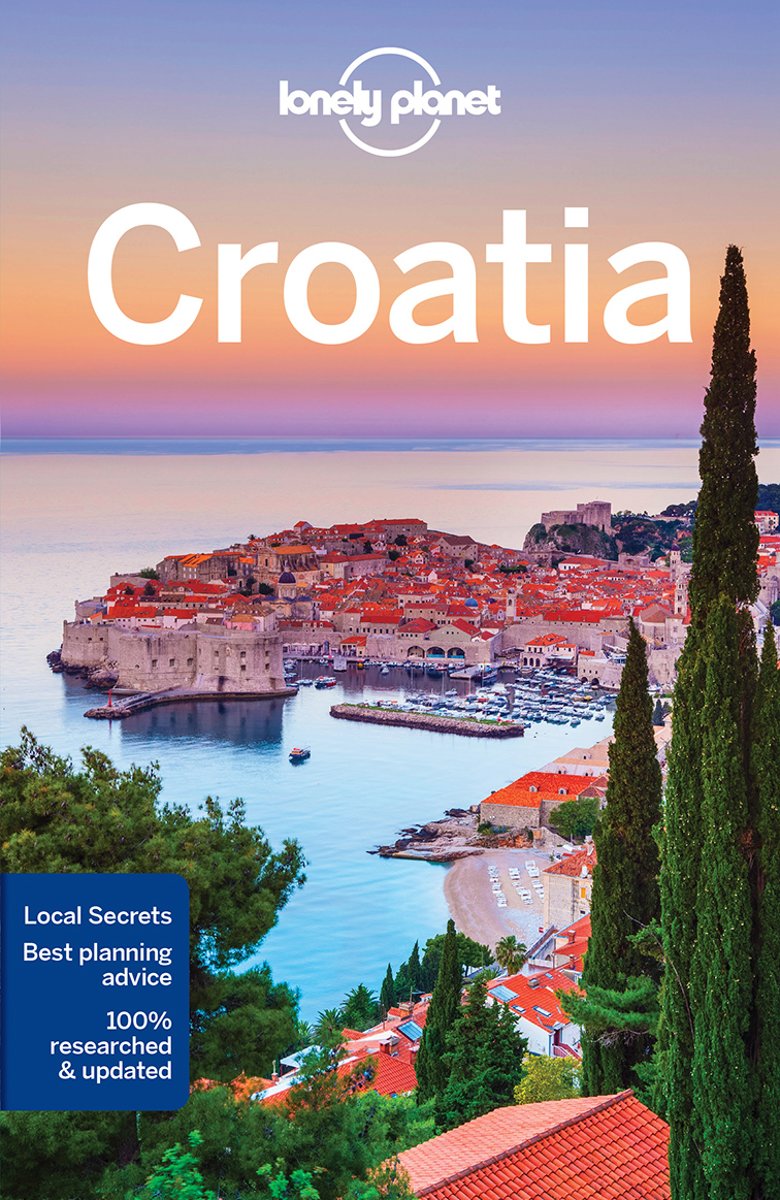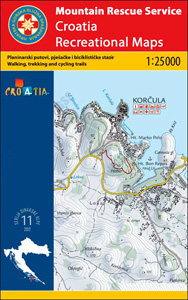Croatie
Description
 Although renowned for its sunny beaches, Croatia does not make haste establishing long distance hiking trails. European long distance trails E6 and E7 are planned to run through Croatia, but hiking enthousiasts will find little more than a dotted line on the map to show where the trail is supposed to come.
Although renowned for its sunny beaches, Croatia does not make haste establishing long distance hiking trails. European long distance trails E6 and E7 are planned to run through Croatia, but hiking enthousiasts will find little more than a dotted line on the map to show where the trail is supposed to come.
So skip Croatia? No, certainly not. The country offers some outstanding mountain landscapes, with towering karst formations, white rocks in polished formations and deep crags. They are part of the Dinaric Alps and typical for Croatia. In between the limestone ranges are forests, and green slopes covered in snow until spring, when the crocuses start to bloom. This makes for some lovely walking, also because temperatures are still agreeable at this time of year. The mountains are not very high. Mount Croatia Dinara is the highest at 1831m, a large dry outcrop surrounded by wilderness.
Walking the mountains is a popular local pastime. The Croatians will tell you where to go and how to find the best mountain huts. There are numerous great 2- or 3-day hikes. Many trails are well kept and marked profusely in red and white. Most popular are the Velebit range, and Paklenica with its bizarre limestone rocks and peaks up to 1750m high.
Don't forget the Adriatic Sea coast with its many islands. These are easy to reach, often interconnected and differ considerably one from the other. Hiking Rab, Pag and Vis is fun, but beware: one hiker stepped on a landmine not long ago, so keep away from any military grounds. Spring and autumn are the best seasons, particularly in these low parts, because summer can get very hot. If you want to go in summer anyway, start out early and carry lots of drinking water.
Sentiers
Régions
Liens
Données
Rapports
Guides et cartes
Hébergement
Organisations
Voyagistes
GPS
Autre
Livres

United Kingdom
- Moon Croatia & Slovenia: With Montenegro (Fourth Edition)
- Beaches & Waterfalls, Coastal Drives, Castles & Ruins Lire la suite

United Kingdom
2019
- Walks and Treks in Croatia
- mountain trails and national parks, including Velebit, Dinara and Plitvice Lire la suite
- Also available from:
- De Zwerver, Netherlands

Netherlands
2019
- Wandelgids Walks and treks in Croatia - Kroatië | Cicerone
- This guide describes day walks and treks in all Croatia's main hiking areas and national parks on the mainland, from the forested hills around Zagreb, to the roof of Croatia on the Bosnian border, and the national parks of Northern Velebit, Paklenica, Risnjak, UNESCO-listed Plitvice Lakes and more. Lire la suite

United Kingdom
- Beyond The Beaches
- Your Ultimate Croatia Travel Guide (An Insider's Guide to Croatia's Hidden Gems) Lire la suite

United Kingdom
2014
- The Islands of Croatia
- 30 walks on 14 Adriatic islands Lire la suite
- Also available from:
- De Zwerver, Netherlands

Netherlands
2014
- Wandelgids Islands of Croatia | Cicerone
- This guidebook describes 30 day walks on the islands of the Croatian Adriatic, ranging from short, easy coastal strolls to more challenging, full day outings over rocky ridges and summits, with spectacular views of the Dalmatian coast. Featuring routes on 14 Croatian islands, including the islands of Hvar and Mljet, as well as quieter islands. Lire la suite

United Kingdom
- Complete Travel Guide to Croatia
- Things You Must Know Before Visiting Croatia Lire la suite
- Also available from:
- De Zwerver, Netherlands

Netherlands
2016
- Rough Guide - Croatia
- The Rough Guide to Croatia is the ultimate travel guide to one of Mediterranean Europe's most beautiful and unspoiled countries.This full-color guide includes reliable and comprehensive coverage of all the sights and attractions, from walking a circuit of Dubrovnik's city walls to exploring the labyrinthine streets of Split to savoring the... Lire la suite
- Also available from:
- Bol.com, Belgium

Belgium
2016
- Rough Guide - Croatia
- The Rough Guide to Croatia is the ultimate travel guide to one of Mediterranean Europe's most beautiful and unspoiled countries.This full-color guide includes reliable and comprehensive coverage of all the sights and attractions, from walking a circuit of Dubrovnik's city walls to exploring the labyrinthine streets of Split to savoring the... Lire la suite

Netherlands
- Croatia
- The third edition of Footprint Croatia gets behind the glossy brochures to uncover the real appeal of this holiday favourite. Medieval towns, Venetian ports and Roman remains vie for attention with a seascape of scattered islands, crystal-clear water and hidden coves. This fully updated guide shows you how to make the most of your stay, with... Lire la suite
- Also available from:
- Bol.com, Belgium

Belgium
- Croatia
- The third edition of Footprint Croatia gets behind the glossy brochures to uncover the real appeal of this holiday favourite. Medieval towns, Venetian ports and Roman remains vie for attention with a seascape of scattered islands, crystal-clear water and hidden coves. This fully updated guide shows you how to make the most of your stay, with... Lire la suite

Netherlands
2018
- Reisgids Kroatien - Kroatië | Reise Know-How Verlag
- Toonaangevende reisgids van Duitse makelij. Zeer degelijk, boordevol praktische informatie en achtergrondbeschrijvingen. Absoluut de een ijzersterke reisgids..... Een aanrader voor zowel de zelfstandige als de georganiseerde reiziger. Dieser Reiseführer deckt die gesamte Küstenregion der Kvarner Bucht und Dalmatiens ab - von Opatija im Norden... Lire la suite

Netherlands
2017
- Croatia
- Lonely Planet: The world's leading travel guide publisher Lonely Planet Croatia is your passport to the most relevant, up-to-date advice on what to see and skip, and what hidden discoveries await you. Sail the island-speckled coastline, marvel at historic forts and mansions or walk Dubrovnik's city walls; all with your trusted travel companion.... Lire la suite
- Also available from:
- Bol.com, Belgium

Belgium
2017
- Croatia
- Lonely Planet: The world's leading travel guide publisher Lonely Planet Croatia is your passport to the most relevant, up-to-date advice on what to see and skip, and what hidden discoveries await you. Sail the island-speckled coastline, marvel at historic forts and mansions or walk Dubrovnik's city walls; all with your trusted travel companion.... Lire la suite

Netherlands
- The Rough Guide to Croatia
- With nearly 2000km of rocky, indented shore and more than 1000 islands, Croatia boasts one of the most dramatic stretches of coastline that Europe has to offer. The Rough Guide’s 24 page full-colour section introduces the author’s highlights, from the medieval city of Dubrovnik to the rural hinterland of Zagreb, to the unspoilt island... Lire la suite
- Also available from:
- Bol.com, Belgium

Belgium
- The Rough Guide to Croatia
- With nearly 2000km of rocky, indented shore and more than 1000 islands, Croatia boasts one of the most dramatic stretches of coastline that Europe has to offer. The Rough Guide’s 24 page full-colour section introduces the author’s highlights, from the medieval city of Dubrovnik to the rural hinterland of Zagreb, to the unspoilt island... Lire la suite
Cartes

United Kingdom
- Lošinj Island Croatian Mountain Rescue Service 25K Map
- The island of Lošinj on the Adriatic coast of Croatia on a double-sided, contoured and GPS compatible map at 1:25,000 from the Croatian Mountain Rescue Service, highlighting hiking paths, including trails on the southern part of Cres and on the nearby islands of Unije, Susak and Ilovik.Contours at 10m intervals enhanced by relief shading... Lire la suite

United Kingdom
- Drava Cartographia Water Sports & Cycling Map
- The course of the river Drava along the border of Hungary and Croatia and its section in Croatia to is confluence with the Danube on a detailed contoured map at 1:75,000 from Cartographia in Budapest highlighting waymarked and recommended cycling routes, etc.The course of the river is presented on four panels. An overprint highlights waymarked... Lire la suite

United Kingdom
- Dinara
- The south-eastern part of the Dinara - Troglav mountain range on the border of southern Croatia and Bosnia-Herzegovina on a contoured and GPS compatible map at 1:25,000 from the Croatian Mountain Rescue Service. Coverage extends southwards from the peak of Troglav to Maljkovo near the Perucko Lake.Contours at 10m intervals enhanced by relief... Lire la suite

United Kingdom
- Biokovo Mountains Croatian Mountain Rescue Service 25K Map
- Biokovo Mountains on the Adriatic coast of Croatia on a contoured and GPS compatible, double-sided map at 1:25,000 from the Croatian Mountain Rescue Service. Coverage includes the resorts of Baška Voda, Makarska,, Tucpi and Podgora.Contours at 10m intervals enhanced by relief shading provide excellent presentation of the terrain, with markings... Lire la suite

United Kingdom
- Omiška Dinara
- Omiška Dinara Mountains on the Adriatic coast of Croatia on a contoured and GPS compatible, double-sided map at 1:25,000 from the Croatian Mountain Rescue Service. Coverage extends from Dugi Rat and Omiš to just beyond Vruja and inland beyond the A1 motorway to the hill along the Cetina River. Contours at 20m intervals enhanced by relief... Lire la suite

United Kingdom
- Brac Island
- The island of Brac on the Adriatic coast of Croatia on a contoured and GPS compatible map at 1:25,000 from the Croatian Mountain Rescue Service, highlighting recommended cycling routes, with 26 routes profiles. The island is shown on both sides of the map with similar cartography (contours at 10m intervals enhanced by relief shading to provide... Lire la suite

United Kingdom
- Dinara - Troglav Group East
- The south-eastern part of the Dinara - Troglav mountain range on the border of southern Croatia and Bosnia-Herzegovina on a contoured and GPS compatible map at 1:25,000 from the Croatian Mountain Rescue Service. Coverage extends southwards from the peak of Troglav to Maljkovo near the Perucko Lake.Contours at 10m intervals enhanced by relief... Lire la suite

United Kingdom
- Dinara - Troglav Group West
- The north-western part of the Dinara - Troglav mountain range on the border of southern Croatia and Bosnia-Herzegovina on a contoured and GPS compatible map at 1:25,000 from the Croatian Mountain Rescue Service. With the peak of Troglav towards the eastern edge of the map, coverage extends from the town of Vrlika northwards to the Martinova... Lire la suite

United Kingdom
- Dalmatian Coast 1 - Zadar - Kornati Islands F&B
- The Dalmatian Coast of Croatia around Zadar and the Kornati Islands on a detailed, indexed map at 1:100,000 from Freytag & Berndt with large icons indicating various facilities including campsites and beaches, ferry connections, etc.Coverage includes the islands of Kormat, Pasman Ugljan, Dugi Otok and the southern part of Pag. The map shows... Lire la suite
- Also available from:
- De Zwerver, Netherlands

Netherlands
- Wegenkaart - landkaart 01 Dalmatische Kust Zadar - Kornaten | Freytag & Berndt
- The Dalmatian Coast of Croatia around Zadar and the Kornati Islands on a detailed, indexed map at 1:100,000 from Freytag & Berndt with large icons indicating various facilities including campsites and beaches, ferry connections, etc.Coverage includes the islands of Kormat, Pasman Ugljan, Dugi Otok and the southern part of Pag. The map shows... Lire la suite

Netherlands
- Wegenkaart - landkaart 736 Slovenie, Kroatie, Bosnie-Herzegowina, Servie, Montenegro, Macedonie | Michelin
- Un voyage, ça se prépare : c?est pourquoi les cartes National Michelin participent à vos déplacements et vos choix d?itinéraires. Lire la suite












































